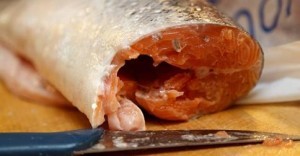
Instead of streaking through the ocean or leaping up rocky streams, it spent three years like a marine couch potato, circling lazily in pens, fattening up on pellets of salmon chow.It was vaccinated as a small fry to survive the diseases that race through these oceanic feedlots, acres of net-covered pens tethered offshore. It was likely dosed with antibiotics to ward off infection or fed pesticides to shed a beard of bloodsucking sea lice.For that rich, pink hue, the fish was given a steady diet of synthetic pigment. Without it, the flesh of these caged salmon would be an unappetizing, pale gray. While many chefs and seafood lovers snub the feedlot variety as inferior to wild salmon, fish farming is booming. What was once a seasonal delicacy now is sometimes as cheap as chicken and available year-round. Now, the hidden costs of mass-producing these once-wild fish are coming into focus.
According to the Norwegian Biotechnology Advisory Board, the Norwegian Food Safety Authority has stopped approving (on a yearly basis) GMOs for use in fish feed that contain genes coding for antibiotic resistance. According to the Advisory Board, this applies to 8 out of 19 GMOs which the fish feed industry had previously been given permission to use since 2008.
“The fear is that genes in the GM feed that code for antibiotic resistance may be taken up by various bacteria in the soil in the country where the GMO is produced, in the feed production chain, or in the gut of the fish. Scientists know little about to what extent, or if, this happens with genes that are inserted via genetic modification, but few would deny that it could happen. If the genes first have entered into a bacterium [during the genetic engineering process], they may quickly spread further.”
This is an important signal …
At the least, they want the farms to switch to solid-walled pens with catch basins to isolate farmed fish — and their diseases, pests and waste — from the environment. The ideal solution, they say, is to have the farmed stock raised in landlocked tanks.Protests notwithstanding, the industry is expected to get a lot bigger. Demand for seafood is rising and will double by 2040, according to the U.N.'s Food and Agriculture Organization. Nearly half the world's wild fisheries are exhausted from overfishing, thus much of the supply will likely come from farmed seafood.
Please Read this Article at NaturalBlaze.com





Leave a Reply